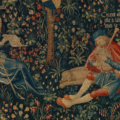An eccentric priest driving around northern Spain in an old Citroën, carrying a few cans of paint left over from roadwork and a paintbrush. That’s what the Civil Guard patrol must have thought, after arresting him in a small village in the Pyrenees in the 1980s. The priest told them he was preparing “a great invasion from France.” Eccentric, sure. But he was no madman. He was the visionary who created one of the most iconic symbols of the Camino de Santiago: the yellow arrow.
Elías Valiña Sampedro was a Spanish priest and scholar, born on February 1 1929 in a small village in the municipality of Sarria, a place deeply linked to the Camino. He died on December 11, 1989 in the Hospital of Calde (Lugo). He was the parish priest of O Cebreiro, at the entrance to the French Way in Galicia, from his ordination on September 21, 1957 until his death. His body is buried there, in the legendary Church of Santa María.
Certainly, being the pastor of this church marked his life. It was one of the first shelters for pilgrims to be built on the Pilgrim’s Way to Santiago de Compostela in the ninth century. Two centuries later, it was entrusted to the Order of Cluny by King Alfonso VI. Here, tradition claims a shocking miracle occurred: bread and wine became real flesh and blood in the hands of a skeptical monk. The buzz drove the Catholic Monarchs themselves to visit the place –but that’s another story that deserves its own article.
A forgotten route
Since the end of the WWII, experts and scholars developed a new, growing interest on Santiago de Compostela. This, despite the fact that the Camino had been largely forgotten for centuries. In more ways than one, this renewal was the work of Valiña Sampedro, as Manuel Garrido explains in his book, El Camino de Santiago: Doce Siglos de Historia (The Way of St. James: Twelve Centuries of History).
He received his doctorate from the Pontifical University of Salamanca in 1965, with a dissertation (naturally) on the Camino de Santiago. This work was awarded the Antonio de Nebrija Prize, granted by the Higher Council for Scientific Research, in 1967. But, of course, he did much more than that. He began by marking the route of the French Way from Villafranca del Bierzo with his famous “yellow arrow,” gathering some volunteers after finally convincing the authorities to support him. He also developed guidebooks for pilgrims. The first of them, Camino a Compostela, was published in 1971. It was soon followed by the famous Guía Roja (Camino de Santiago: Guía del Peregrino), published in 1985.
Aware of the fact that pilgrimage means meeting people, he also distinguished himself as a cultural promoter and defender of the interests of the O Cebreiro region. His work was fundamental in the revitalization of this historic place and in the promotion of the Camino as a mass phenomenon. Throughout his life, he was known for his commitment to justice and the welfare of the community, advocating for education, access to running water and electricity, and the development of local infrastructure.
He was an active advocate for the Camino in the political and social spheres, to the point that he was appointed Commissioner of the Camino de Santiago. In this role, he promoted the creation of the Boletín del Camino de Santiago, a periodic publication that documented the life of the Camino and contributed to raising awareness of its importance. This bulletin was published from July 1985 to August 1987. In 1987, he led a team promoting the network of hostels for pilgrims on the French Way. In the same year, the Council of Europe recognized it as the first European Cultural Route.
Elías Valiña died in 1989, having seen from afar the “invasion” that finally took place in third millennium: in 2023, the number of pilgrims would approach half a million per year, compared to barely 5,000 pilgrims in 1990. And this is just the beginning.





